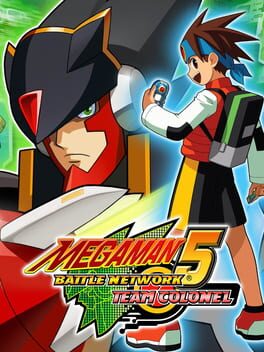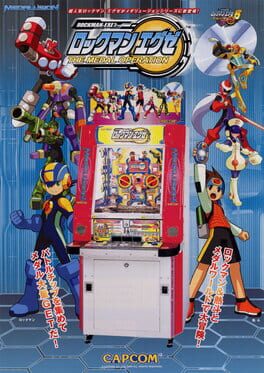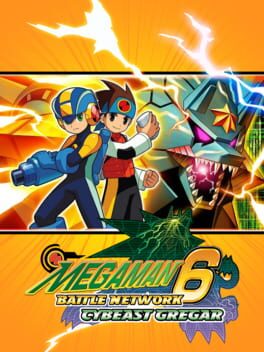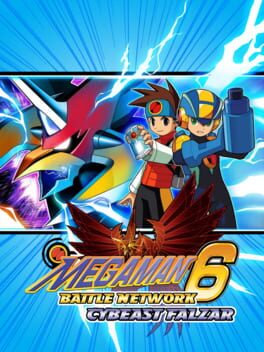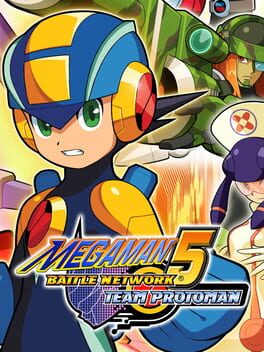

Team Colonel is the second edition of Mega Man Battle Network 5. In the game, you can join forces with characters from previous installments of the Mega Man Battle series, and you can play in a new fighting mode. Team up with other cyberheroes in an effort to stop an evil organization from taking control of the global Internet.
Also in series
Reviews View More
Decided to skip 4 and go straight to this since I played a lot of 4 as a kid. BN5 has the least amount of padding, an incredibly good chip selection, and fairly well design boss fights, but falls short in the story and scenario department. Things like the different locations and exploration are relatively forgettable as well.
Liberation missions are neat, mainly due to being able to use other Navis, but they can be frustrating due to RNG. Sometimes, the game just refuses to give you the chips you need to beat a group of enemies in three turns. Sure you can attribute that to having a poorly made chip folder, but I still feel like RNG can screw you over. Overall though, they're surprisingly well done.
Most of the boss fights are actually pretty good this time, but god that final boss is just awful. Due to how the final boss is designed, at least half of my chip folder was rendered useless, so I had to reload and completely remake the folder I had been using for most of the game. Having a gimmicky final boss that forces you to use a specific set of chips is just awful design in a game like this.
Oh yeah there's also that "defeat 100 samurai" minigame that's required to progress. It only took me a few tries, but Jesus Christ what the fuck Capcom?
Regardless, still a pretty good game. Think I still like BN3 slightly more, but this is definitely worth playing. Glad I could finally finish this after getting filtered by Cloudman as a 12-year-old.
Liberation missions are neat, mainly due to being able to use other Navis, but they can be frustrating due to RNG. Sometimes, the game just refuses to give you the chips you need to beat a group of enemies in three turns. Sure you can attribute that to having a poorly made chip folder, but I still feel like RNG can screw you over. Overall though, they're surprisingly well done.
Most of the boss fights are actually pretty good this time, but god that final boss is just awful. Due to how the final boss is designed, at least half of my chip folder was rendered useless, so I had to reload and completely remake the folder I had been using for most of the game. Having a gimmicky final boss that forces you to use a specific set of chips is just awful design in a game like this.
Oh yeah there's also that "defeat 100 samurai" minigame that's required to progress. It only took me a few tries, but Jesus Christ what the fuck Capcom?
Regardless, still a pretty good game. Think I still like BN3 slightly more, but this is definitely worth playing. Glad I could finally finish this after getting filtered by Cloudman as a 12-year-old.
Got my hopes up with the unique dungeon at the start before going back and forth between internet padding and actual dungeons. Bonus points for said dungeons being obnoxious. Disappointed with the boss fights. Biggest plus is double soul improvements. Liberation missions I actually liked but its a fraction of the game time. And that is all that really makes this one stand out. The majority is just another BN game making you run around doing errands.
The squandered potential of Battle Network 4’s departures and innovations sees its just due in this immediate sequel, shedding the majority of its hostile design principles while continuing to reinvent the core gameplay formula around progressive new concepts, in harmony with the overarching spirit the series has maintained across five mainline titles. The promising Double Soul mechanic introduced in the last game is realized to its full potential here, partnered alongside a congenial new party system and a more tactical gameplay structure nestled within the familiar trajectory the series primarily promotes. Even the fumbled Dark Chip concept quickly forgotten in 4 proves actually enticing here, fleshing out the mechanic into an inviting risk/reward system actively interwoven with the main narrative of the game, and affected by the central mechanics core gameplay is built around. Most importantly, though, is how the game weaves its fundamental designs around an engaging plot and cast of characters, filled with new and familiar faces alike, whose personalities excel at investing you in this most ambitious adventure for the series so far. The experience isn’t so ideal as to be completely free of the tedium and annoyances which by now can be seen as signature flaws of the franchise, but the fundamental evolutions of the gameplay, in tandem with its robust narrative and endearing band of allies, are such that it is an effective culmination of all the major tenets the series has thus far built for itself—both good and bad.
The primary battle system the series is known for remains intuitive and strategically complex. The combination of turn-based, deck-building combat executed on a gridded battlefield remains a winning formula, particularly as the various new mechanics continue to build upon this strong foundation in engaging and innovative ways. Although mainstay functions such as Program Advances were severely limited in this entry, incentives for conscientious deck-building are further encouraged by means of the returning Double Soul mechanic and the new party system present in the game’s premier addition for the series: Liberation Missions. These advanced tactical challenges lie at the heart of the game’s narrative, tasking you to free various areas across the net which have been occupied by an evil organization known as Nebula. Liberation Missions shake up the traditional Battle Network gameplay by employing tactics-style stratagems to clear tile-oriented objectives of increasing size and difficulty. Each new Liberation Mission gives you a new team member to operate, often a familiar Navi opponent from a previous Battle Network title, who has been persuaded to assist you in freeing the net of this latest tyrannical threat. The unique opportunity to operate other Navis is a first for the series, and with it comes an increased variety in playstyle, as they all have unique properties and powers to utilize when it comes to battling. Although you still battle with the same chip folder you use with MegaMan, each Navi boasts a unique chip only accessible to them once per battle, typically a very powerful attack with a code associated to their name. As you expand your chip library, it makes sense then to keep in mind synergistic builds for operating not just MegaMan, but all the allies you’ll eventually partner with, as a balanced deck is the key to pulling off each Liberation Mission in the least amount of turns, earning you the greatest reward at the end.
The conclusion of each mission also rewards you with the corresponding Double Soul of the most recent Navi recruited to your cause. Just as in the previous game, Double Soul imbues MegaMan with the associated properties of the Navis he has formed a special bond with, effectively emulating the power-copying ability intrinsic to the original MegaMan games when defeating the various Robot Masters. It continues to be a very motivating mechanic that accelerates gameplay, enlivening the endless combat encounters of the game by offering a wide range of opportunities for quick kills and combos when effectively helmed. The mechanic enjoys a greater sense of implementation here thanks to the continued presence of the respective Navis throughout the game via Liberation Missions, solidifying their character-motivated attribute of a personal bond having been formed between MegaMan and his teammates. While less important than the mechanical functionality of the gimmick, the efforts taken to intermingle gameplay and story is one of the stronger components of Battle Network 5’s presentation. You miss out a bit on the running narrative previous games maintained of Lan’s struggle to balance childhood escapades with daring pursuits of evil antagonists, but it’s largely mitigated thanks to this entry’s more sober disposition. A more dramatic narrative engages us from the outset of the game, carrying with it the most plausible sense of threat the series has thus far seen. When first journeying onto the net after Nebula has begun its occupation, there exists a sense of menace unknown to the series outside of the Undernet, which has always possessed a kind of cartoonish gloom in contrast to this. Even after you’re able to liberate these spaces, there remains a kind of inhospitable feeling in their design. Unfortunately, that lingering dread is not so much a result of immersive storytelling, but rather, the unrelenting bugbear of discommodious level design.
The series has been somewhat inconsistent with this recurring issue, progressing and regressing across various titles, but appearing to exist in some form or another in almost every entry. Battle Network 5’s labyrinthian interpretation of the net is a marked step up from its predecessor, but still lacks integral elements of clarity and ease of navigation, as well as distinctive identities for the various spaces associated with real world counterparts. The amount of backtracking the game requires often compounds this frustration, as you’re often asked to head deep into the net for a particular objective, only to then be taken back to the real world before going back to that same place on the net, with no means of quickly traversing there via some easily accessible shortcut. Between this, and the game’s tendency to reuse already exhausted dungeons for additional story beats, the obvious padding of the game and stretching of assets becomes quite obnoxious. It’s not even logically implemented, in that you could return to each of the major areas for some new challenge or relevant narrative moment. One of the dungeons is inexplicably reused for three separate events, while another serves as the last location you need to check for an inane story quest which in no way points you towards relitigating a prior dungeon as the necessary objective. Even Liberation Missions suffer from these frustrating conceits, as although their layouts suit the tactical mission structure in which they’re introduced, the vast spaces which previously served as a battlefield end up as little more than hollow hallways for the rest of the game. It really undermines the sense that you’re “liberating” much of anything when all that appears after you return are a handful of NPCs with nothing but meaningless dialogue to offer you.
The game in general suffers from a want of engagement outside its core narrative. There’s still the meager interactions of trade quests and quiz characters to interact with, but the absence of more definitive side quests hurts the whole of the experience in the grand scheme. It is a very good thing, then, that the base game is fundamentally compelling enough to more or less make up for the lack of these features almost entirely. The core gameplay has never felt better for the series, with an array of synergistic chip types pairing with the revitalized Double Soul mechanic to make combat feel consistently fresh and exciting throughout the game. The mechanics of the game meld with the story and characters in a way that is most satisfying, all while introducing an unexpected evolution for the series that further emphasizes its tactical fundamentals. As a final note of merit, the game’s soundtrack warrants praise, as it highlights the previously unmentioned strengths the series has always had for melodic compositions on a console notoriously remembered for its abysmal sound quality. Many of the tracks are new mixes of familiar themes, balancing the soundtrack between more whimsical interpretations of nostalgic motifs and sinister new accompaniments for the darker tone certain segments maintain. Battle Network 5 is an overall outstanding entry, notwithstanding the few remaining issues the series insists upon in an effort to puzzle and provoke the player as a means of challenge. The confident strides the game takes in advancing the series are too successful to be hampered by these frustrations, however, with the impressive amalgamation of narrative and gameplay being a particular coup to set this entry apart from its noteworthy predecessors.
The primary battle system the series is known for remains intuitive and strategically complex. The combination of turn-based, deck-building combat executed on a gridded battlefield remains a winning formula, particularly as the various new mechanics continue to build upon this strong foundation in engaging and innovative ways. Although mainstay functions such as Program Advances were severely limited in this entry, incentives for conscientious deck-building are further encouraged by means of the returning Double Soul mechanic and the new party system present in the game’s premier addition for the series: Liberation Missions. These advanced tactical challenges lie at the heart of the game’s narrative, tasking you to free various areas across the net which have been occupied by an evil organization known as Nebula. Liberation Missions shake up the traditional Battle Network gameplay by employing tactics-style stratagems to clear tile-oriented objectives of increasing size and difficulty. Each new Liberation Mission gives you a new team member to operate, often a familiar Navi opponent from a previous Battle Network title, who has been persuaded to assist you in freeing the net of this latest tyrannical threat. The unique opportunity to operate other Navis is a first for the series, and with it comes an increased variety in playstyle, as they all have unique properties and powers to utilize when it comes to battling. Although you still battle with the same chip folder you use with MegaMan, each Navi boasts a unique chip only accessible to them once per battle, typically a very powerful attack with a code associated to their name. As you expand your chip library, it makes sense then to keep in mind synergistic builds for operating not just MegaMan, but all the allies you’ll eventually partner with, as a balanced deck is the key to pulling off each Liberation Mission in the least amount of turns, earning you the greatest reward at the end.
The conclusion of each mission also rewards you with the corresponding Double Soul of the most recent Navi recruited to your cause. Just as in the previous game, Double Soul imbues MegaMan with the associated properties of the Navis he has formed a special bond with, effectively emulating the power-copying ability intrinsic to the original MegaMan games when defeating the various Robot Masters. It continues to be a very motivating mechanic that accelerates gameplay, enlivening the endless combat encounters of the game by offering a wide range of opportunities for quick kills and combos when effectively helmed. The mechanic enjoys a greater sense of implementation here thanks to the continued presence of the respective Navis throughout the game via Liberation Missions, solidifying their character-motivated attribute of a personal bond having been formed between MegaMan and his teammates. While less important than the mechanical functionality of the gimmick, the efforts taken to intermingle gameplay and story is one of the stronger components of Battle Network 5’s presentation. You miss out a bit on the running narrative previous games maintained of Lan’s struggle to balance childhood escapades with daring pursuits of evil antagonists, but it’s largely mitigated thanks to this entry’s more sober disposition. A more dramatic narrative engages us from the outset of the game, carrying with it the most plausible sense of threat the series has thus far seen. When first journeying onto the net after Nebula has begun its occupation, there exists a sense of menace unknown to the series outside of the Undernet, which has always possessed a kind of cartoonish gloom in contrast to this. Even after you’re able to liberate these spaces, there remains a kind of inhospitable feeling in their design. Unfortunately, that lingering dread is not so much a result of immersive storytelling, but rather, the unrelenting bugbear of discommodious level design.
The series has been somewhat inconsistent with this recurring issue, progressing and regressing across various titles, but appearing to exist in some form or another in almost every entry. Battle Network 5’s labyrinthian interpretation of the net is a marked step up from its predecessor, but still lacks integral elements of clarity and ease of navigation, as well as distinctive identities for the various spaces associated with real world counterparts. The amount of backtracking the game requires often compounds this frustration, as you’re often asked to head deep into the net for a particular objective, only to then be taken back to the real world before going back to that same place on the net, with no means of quickly traversing there via some easily accessible shortcut. Between this, and the game’s tendency to reuse already exhausted dungeons for additional story beats, the obvious padding of the game and stretching of assets becomes quite obnoxious. It’s not even logically implemented, in that you could return to each of the major areas for some new challenge or relevant narrative moment. One of the dungeons is inexplicably reused for three separate events, while another serves as the last location you need to check for an inane story quest which in no way points you towards relitigating a prior dungeon as the necessary objective. Even Liberation Missions suffer from these frustrating conceits, as although their layouts suit the tactical mission structure in which they’re introduced, the vast spaces which previously served as a battlefield end up as little more than hollow hallways for the rest of the game. It really undermines the sense that you’re “liberating” much of anything when all that appears after you return are a handful of NPCs with nothing but meaningless dialogue to offer you.
The game in general suffers from a want of engagement outside its core narrative. There’s still the meager interactions of trade quests and quiz characters to interact with, but the absence of more definitive side quests hurts the whole of the experience in the grand scheme. It is a very good thing, then, that the base game is fundamentally compelling enough to more or less make up for the lack of these features almost entirely. The core gameplay has never felt better for the series, with an array of synergistic chip types pairing with the revitalized Double Soul mechanic to make combat feel consistently fresh and exciting throughout the game. The mechanics of the game meld with the story and characters in a way that is most satisfying, all while introducing an unexpected evolution for the series that further emphasizes its tactical fundamentals. As a final note of merit, the game’s soundtrack warrants praise, as it highlights the previously unmentioned strengths the series has always had for melodic compositions on a console notoriously remembered for its abysmal sound quality. Many of the tracks are new mixes of familiar themes, balancing the soundtrack between more whimsical interpretations of nostalgic motifs and sinister new accompaniments for the darker tone certain segments maintain. Battle Network 5 is an overall outstanding entry, notwithstanding the few remaining issues the series insists upon in an effort to puzzle and provoke the player as a means of challenge. The confident strides the game takes in advancing the series are too successful to be hampered by these frustrations, however, with the impressive amalgamation of narrative and gameplay being a particular coup to set this entry apart from its noteworthy predecessors.
